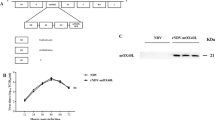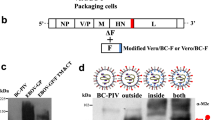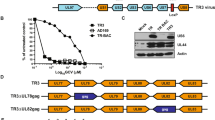Abstract
This is the first report describing recombinant (rec) Newcastle disease virus (NDV) as vector for gene therapy of cancer. The gene encoding granulocyte/macrophage colony-stimulating factor (GM-CSF) was inserted as an additional transcription unit at two different positions into the NDV genome. The rec virus with the strongest production of the gene product (rec(GM-CSF)) was selected for our study. The insertion of the new foreign gene did neither affect the main features of NDV replication nor its tumor selectivity. The gene product was biologically active and stable. Tumor vaccine cells infected by rec(GM-CSF) stimulated human peripheral blood mononuclear cells (PBMC) to exert antitumor bystander effects in vitro in a tumor neutralization assay. These effects were significantly increased when compared to vaccine infected by rec(−) virus. Furthermore, rec(GM-CSF) led to a much higher interferon-α (IFN-α) production than rec(−) when added as virus or as virus-modified vaccine to PBMC. Two distinct cell types, monocytes and plasmacytoid dendritic cells were shown to contribute to the augmented IFN-α response of PBMC. In conclusion, the already inherent anti-neoplastic and immunostimulatory properties of NDV could be further augmented by the introduction of a therapeutic gene whose product initiates a broad cascade of immunological effects in the microenvironment of the vaccine.
This is a preview of subscription content, access via your institution
Access options
Subscribe to this journal
Receive 12 print issues and online access
$259.00 per year
only $21.58 per issue
Buy this article
- Purchase on Springer Link
- Instant access to full article PDF
Prices may be subject to local taxes which are calculated during checkout







Similar content being viewed by others
References
Lorence RM, Pecora AL, Major PP, Hotte SJ, Laurie SA, Roberts MS et al. Overview of phase I studies of intravenous administration of PV701, an oncolytic virus. Curr Opin Mol Ther 2003; 5: 618–624.
Schirrmacher V, Haas C, Bonifer R, Ahlert T, Gerhards R, Ertel C . Human tumor cell modification by virus infection: an efficient and safe way to produce cancer vaccine with pleiotropic immune stimulatory properties when using Newcastle Disease Virus. Gene Therapy 1999; 6: 63–73.
Sinkovics JG, Horvath JC . Newcastle Disease Virus (NDV): brief history of its oncolytic strains. J Clin Virol 2000; 16: 1–15.
Gallucci S, Matzinger P . Danger signals: SOS to the immune system. Curr Opin Immunol 2001; 13: 114–119.
Zeng J, Fournier P, Schirrmacher V . Induction of interferon α and tumor necrosis factor-related apoptosis-inducing blood mononuclear cells by hemagglutinin-neuraminidase but not F protein of Newcastle Disease Virus. Virology 2002; 297: 19–30.
Fournier P, Zeng J, Schirrmacher V . Two ways to induce innate immune responses in human PBMCs: paracrine stimulation of IFN-α responses by viral protein or dsRNA. Int J Oncol 2003; 23: 673–680.
Kato H, Sato S, Yoneyama M, Yamamoto M, Uematsu S, Akira S et al. Cell type-specific involvement of RIG-I in antiviral response. Immunity 2005; 23: 19–28.
Clemens MJ, Elia A . The double-stranded RNA-dependent protein kinase PKR: structure and function. J Interferon Cytokine Res 1997; 17: 503–524.
Akira S, Takeda K . Toll-like receptor signalling. Nat Rev Immunol 2004; 4: 499–511.
Heicappell R, Schirrmacher V, von Hoegen P, Ahlert T, Appelhans B . Prevention of metastatic spread by postoperative immunotherapy with virally modified autologous tumor cells. I: parameters for optimal therapeutic effects. Int J Cancer 1986; 37: 569.
Schirrmacher V, Heicappell R . Prevention of metastatic spread by postoperative immunotherapy with virally modified autologous tumor cells. II: Establishment of specific systemic anti tumor immunity. Clin Exptl Met 1987; 5: 147–156.
Washburn B, Schirrmacher V . Human tumor cell infection by Newcastle Disease Virus leads to upregulation of HLA and cell adhesion molecules and to induction of interferons, chemokines and finally apoptosis. Int J Oncol 2002; 21: 85–93.
Steiner HH, Bonsanto MM, Beckhove P, Brysch M, Geletneky K, Ahmadi R et al. Anti-tumor vaccination of patiens with glioblastoma multiforme in a case-control study: feasibility, safety and clinical benefit. J Clin Oncol 2004; 22: 4272–4281.
Karcher J, Dyckhoff G, Beckhove P, Reisser C, Brysch M, Zionta Y et al. Anti-tumor vaccination with HNSCC with autologous virus-modified tumor cells. Cancer res 2004; 64: 8057–8061.
Peeters BP, de Leeuw OS, Koch G, Gielkens AL . Rescue of Newcastle Disease Virus from cloned cDNA: evidence that cleavability of the fusion protein is a major determinant for virulence. J Virol 1999; 73: 5001–5009.
Schirrmacher V . Clinical trials of antitumor vaccination with an autologous tumor cell vaccine modified by virus infection: Improvement of patient survival based on improved anti-tumor immune memory. Cancer Immunol Immunother 2005; 54: 587–598.
Zhao H, Peeters BPH . Recombinant Newcastle disease virus as a viral vector: effect of genomic location of foreign gene on gene expression and virus replication. J Gen Virol 2003; 84: 781–788.
Haas C, Lulei M, Fournier P, Arnold A, Schirrmacher V . A tumor vaccine containing anti-CD3 and anti-CD28 bispecific antibodies triggers strong and durable anti-tumor activity in human lymphocytes. Int J Cancer 2005; 118: 658–667.
Dzionek A, Sohma Y, Nagafune J, Cella M, Colonna M, Facchetti F et al. BDCA-2, a novel plasmacytoid dendritic cell-specific type II C-type lectin, mediates antigen capture and is a potent inhibitor of interferon alpha/beta induction. J Exp Med 2001; 194: 1823–1834.
Schirrmacher V, Haas C, Bonifer R, Ertel C . Virus potentiation of tumor vaccine T-cell stimulatory capacity requires cell surface binding but not infection. Clin Cancer Res 1997; 3: 1135–1148.
Parney IF, Chang LJ, Farr-Jones MA, Hao C, Smylie M, Petruk KC . Technical hurdles in a pilot clinical trial of combined B7–2 and GM-CSF immunogene therapy for glioblastomas and melanomas. J Neurooncol 2006; 78: 71–80.
Liang W, Wang H, Sun TM, Yao WQ, Chen LL, Jin Y et al. Application of autologous tumor cell vaccine and NDV vaccine in treatment of tumors of digestive tract. World J Gastroenterol 2003; 9: 495–498.
Fiola C, Peeters B, Fournier P, Arnold A, Bucur M, Schirrmacher V . Tumor selective replication of Newcastle Disease Virus: Association with defects of tumor cells in anti-viral defence. Int J Cancer 2006; 119: 328–338.
Scheffer SR, Nave H, Korangy F, Schlote K, Pabst R, Jaffee EM et al. Apoptotic, but not necrotic, tumor cell vaccines induce a potent immune response in vivo. Int J Cancer 2003; 103: 205–211.
Soiffer R, Hodi FS, Haluska F, Jung K, Gillessen S, Singer S et al. Vaccination with irradiated, autologous melanoma cells engineered to secrete granulocyte-macrophage colony-stimulating factor by adenoviral-mediated gene transfer augments antitumor immunity in patients with metastatic melanoma. J Clin Oncol 2003; 21: 3343–3350.
Jaffee EM, Lazenby A, Meurer J, Marshall F, Hauda KM, Counts C et al. Use of murine models of cytokine-secreting tumor vaccines to study feasibility and toxicity issues critical to designing clinical trials. J Immunother Emphasis Tumor Immunol 1995; 18: 1–9.
Dranoff G, Jaffee E, Lazenby A, Golumbek P, Pardoll D, Mulligan RC et al. Vaccination with irradiated tumor cells engineered to secrete murine granulocyte-macrophage colony-stimulating factor stimulates potent, specific, and long-lasting anti-tumor immunity. Proc Natl Acad Sci USA 1993; 90: 3539–3543.
Driessens G, Hamdane M, Cool V, Velu T, Bruyns C . Highly successful therapeutic vaccination combining dendritic cells and tumor cells secreting granulocyte macrophage colony-stimulating factor. Cancer Res 2004; 64: 8435–8442.
Luiten RM, Kueter EW, Mooi W, Gallee MP, Rankin EM, Gerritsen WR et al. Immunogenicity, including vitiligo, and feasibility of vaccination with autologous GM-CSF-transduced tumor cells in metastatic melanoma patients. J Clin Oncol 2005; 23: 8978–8991.
Wiseman CL, Kharazi A . Objective clinical regression of metastatic breast cancer in disparate sites after use of whole-cell vaccine genetically modified to release sargramostim. Breast J 2006; 12: 475–480.
Qin HX, Chatterjee SK . Construction of recombinant vaccinia virus expressing GM-CSF and its use as tumor vaccine. Gene Therapy 1996; 3: 59–66.
Santos K, Duke CM, Dewhurst S . Amplicons as vaccine vectors. Curr Gene Ther 2006; 6: 383–392.
Stetson DB, Medzhitov R . Type I interferons in host defense. Immunity 2006; 25: 373–381.
Hurwitz AA, Yu TF, Leach DR, Allison JP . CTLA-4 blockade synergizes with tumor-derived granulocyte-macrophage colony-stimulating factor for treatment of an experimental mammary carcinoma. Proc Natl Acad Sci USA 1998; 95: 10067–10071.
Li B, Lalani AS, Harding TC, Luan B, Koprivnikar K, Huan Tu G et al. Vascular endothelial growth factor blockade reduces intratumoral regulatory t cells and enhances the efficacy of a GM-CSF-secreting cancer immunotherapy. Clin Cancer Res 2006; 12: 6808–6816.
Machiels JP, Reilly RT, Emens LA, Ercolini AM, Lei RY, Weintraub D et al. Cyclophosphamide, doxorubicin, and paclitaxel enhance the antitumor immune response of granulocyte/macrophage-colony stimulating factor-secreting whole-cell vaccines in HER-2/neu tolerized mice. Cancer Res 2001; 61: 3689–3697.
Prell RA, Li B, Lin JM, VanRoey M, Jooss K . Administration of IFN-α enhances the efficacy of a granulocyte macrophage colony stimulating factor-secreting tumor cell vaccine. Cancer Res 2005; 65: 2449–2456.
Washburn B, Weigand MA, Grosse-Wilde A, Janke M, Stahl H, Rieser E et al. TNF-related apoptosis-inducing ligand mediates tumoricidal activity of human monocytes stimulated by Newcastle disease virus. J Immunol 2003; 170: 1814–1821.
LeBon A, Tough DF . Links between innate and adaptive immunity via type I interferon. Curr Opin Immunol 2002; 14: 432–436.
Tough DF . Type I interferon as a link between innate and adaptive immunity through dendritic cell stimulation. Leuk Lymphoma 2004; 45: 257–264.
Author information
Authors and Affiliations
Corresponding author
Rights and permissions
About this article
Cite this article
Janke, M., Peeters, B., de Leeuw, O. et al. Recombinant Newcastle disease virus (NDV) with inserted gene coding for GM-CSF as a new vector for cancer immunogene therapy. Gene Ther 14, 1639–1649 (2007). https://doi.org/10.1038/sj.gt.3303026
Received:
Revised:
Accepted:
Published:
Issue Date:
DOI: https://doi.org/10.1038/sj.gt.3303026
Keywords
This article is cited by
-
The phosphatase and tensin homolog gene inserted between NP and P gene of recombinant Newcastle disease virus oncolytic effect test to glioblastoma cell and xenograft mouse model
Virology Journal (2022)
-
Newcastle disease virus mediated apoptosis and migration inhibition of human oral cancer cells: A probable role of β-catenin and matrix metalloproteinase-7
Scientific Reports (2019)
-
Evaluation of a Recombinant Newcastle Disease Virus Expressing Human IL12 against Human Breast Cancer
Scientific Reports (2019)
-
Oncolytic Newcastle disease virus expressing chimeric antibody enhanced anti-tumor efficacy in orthotopic hepatoma-bearing mice
Journal of Experimental & Clinical Cancer Research (2015)
-
Oncolytic tanapoxvirus expressing FliC causes regression of human colorectal cancer xenografts in nude mice
Journal of Experimental & Clinical Cancer Research (2015)



